#he finally cut the bonds and had johnny film him!!
Explore tagged Tumblr posts
Text
some rambles below about the potential if johnny had had a biological dad in cobra kai instead of a stepfather (i stress “rambles” this isn’t organised)
wondering about the version of johnny who does have a bio-dad who’s just like... johnny-but-worse in a different way to how kreese is johnny-but-worse, that is while johnny was presented as a spoiled rich kid who’s kind of mindlessly aggressive/being encouraged in that by kreese, his dad could be a republican (homophobic) economist or stocktrader or smthin, some guy for whom all these trappings and johnny and laura are part of the scenery of his success (like a don draper type but less charismatic) --
which is sort of what they were trying to do with sid, but that messaging got lost the second they forgot that johnny was designed to be the blonde über-american foil to the immigration and outsider daniel and miyagi story, and sid of course cannot be that metaphor! (thinks also forever fondly about the fic about sid getting into the country club, but still being an outsider, and wonders if there’s some way of incorporating that idea into this story, but for now, placing his lost potential gently aside)
what would it mean for a johnny who really did have all the chances to do whatever he wanted, provided he played by his real life father’s rules and his dream was to... be gay do karate? was he disowned? has he essentially disowned himself? is his father dead or alive? is there still money to be had that johnny refuses to touch? does his real life father bail him out of jail over and over and that is the extent to which he’ll help him (while also being disgusted/disappointed by his continued alcoholism, not because he himself isn’t maybe an alcoholic in the correct way, but because johnny is so obvious about it or something along those lines)? would they bump into each other end s3 at the country club?
also I realise here that this is the narrative they gave to terry, and the parallel narrative would still work, considering terry did do what his family ordered him to and johnny just... couldn’t
love a good “karate is a phase” metaphor + it would have made the sources of johnny’s pain not be his jewish stepdad (reliably removed from having to be blood-related or have anything to do with johnny’s purpose in the original film) and instead be literally all the things that were put in place for boys like him to grow up into privilege and for some Unknown Reason he was unable to fulfil that expected goal
it also would have brought johnny’s parentage more to the front, because sid is never really particularly involved in the karate war and johnny cuts ties with him pretty fast (and then ed asner died, so idk if they were intending more), but if his actual, powerful, still-invested-in-his-stock-on-some-level father were in the plot there’d be way more you could do with that (maybe especially if he were dying? johnny is his final legacy?)
+ the core of Stuff that was increasingly forgotten by the show was also that daniel and miyagi were not related by blood, they became family by choice and to have that be a stronger bond in comparison to a johnny and his biological dad....? the idea that biological family ain’t everything and you can choose! (cries in s5.....)
laura could still have been someone either someone who came from a poor background and he married her for her looks/youth, but I also like the laura who kind of parallels ali, whose parents in the first movie ofc very much try to “push” her towards a more suitable boyfriend in... the violent and disrespectful of her boundaries johnny lawrence
there’d be a whole interesting subplot at that point of characters who didn’t come from money who were able to find a way to make their own way in life, vs characters who did come from money who got trapped in cycles of violence by doing what was expected and then visited that violence on people without as much power as them in order to assert control, and johnny attempting somehow to break that cycle without knowing how or why or even that he was really doing it by breaking from his father
ofc you coulda also killed the guy early on and had johnny’s main narrative revolve around laura, but that would assume a story that puts mothers on equal footing and it always struggled with that a bit, even back in the movie days -- tbh the only thing that I would really take from all of that, is that her maiden-name was lawrence and johnny used her name the whole time, and possibly that the full break between johnny and [insert father] was her death
bringing back sid for a sec, simply to wonder about fitting in a guy like him who’s managed to get into “the club” because off the top of my head I mainly think he belongs in a slightly different story, but if someone has something they’d like to say to that am all ears!
11 notes
·
View notes
Photo







ʀʏ☆ • 阿吽のビーツ ᵂᵉ ʷᵉʳᵉ ˢᵘᵖᵖᵒˢᵉᵈ ᵗᵒ ᵇᵉ ᶠʳᵒᵐ ⁿᵒʷ ᵘⁿᵗⁱˡ ᶠᵒʳᵉᵛᵉʳ.
#Ry☆#odorite#odottemita#pls click the images for more silly commentary#also the gifs might be ugly but the video is certainly not pls watch it#*clears throat*#just when I thought that my top 5 dances of the year would stay the same#cutiebutt comes and fucks that up too#This video.... is the shit okay#like for being a cutiebutt video.... is the shit#he finally cut the bonds and had johnny film him!!#I'm in fucking love right now#Tbh I didn't remember this choreo so at the beginning I thought shit this is another cutiebutt thing#but then I see the hand motions and I say FUCK IT'S ATY'S#and I pause the video#and take a deep breath#and ready myself to continue#bear in mind I stayed up late to watch it and got my mind fucked because... it's good#it's genuinely good; the lighting; the outfit; the makeup it's fucking perfect my dudes#also cutiebutt dancing with a facemask?? way to fucking make me feel valid???#I was so impressed by the way his movements remained v expressive without showing his face#something I aspire to be able to do one day#A N D#honestly?? cutiebutt has this thing to make a dance look so different from the original??? it happened with ELECT too!#like literally all the steps are the fucking same but somehow they feel different??#cutiebutt teach me dude#kyo; I was physically; morally and spiritually OFFENDED#by this video#i love my boy the ironing table his chest is so flat I'm jealous
12 notes
·
View notes
Photo
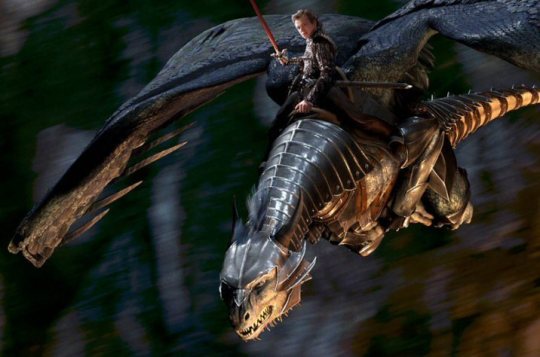
I have so many feelings and feeling-shaped things attached to the Eragon movie that I don’t know how to approach this review. If you weren’t a fan of the book eagerly awaiting this movie like I was–I must have watched the tailor like thirty times when it was released–you can’t understand the excitement for this movie, followed by the disappointment in how little regard for the source material the movie had. AND THEN all the fan reactions.
There was this guy–username was Thorin Oakenshield–on the Inheritance Forums of Shurtugal.com that wrote, like, a song? Or a rap? “The Eragon movie/Was less than groovy/This song it made me sing/Bad images did it bring”.
I probably got it horribly wrong, but I’m amazed that I remember that much.
And there was this one person who made a post arguing that actually, this was an Oscar-worthy movie, and we were all being unduly harsh, and in hindsight, that person was _definitely_ trolling all of us, but we were all worked up about it.
Anyhow I kind of love this movie even though it’s a cold mess.
[Sorry, this might be rambling. But YES I have all the books, and YES I have written to the author–and he wrote BACK!]
Alright, so, the story goes like this: Christopher Paolini was a fantasy and sci-fi fanboy living in rural Montana and his local library ran out of books for him to read. So at fifteen he decided to write his own book, and he got it published with his parents’ small publishing house. And like, yeah, it contained a lot of obvious shout-outs and homages to books he liked, maybe TOO much, but he worked his butt off promoting it by going to schools and stuff in costume to ask people to buy his book. It got noticed by Carl Hiaasen of Hoot fame, and Knopf picked it up, edited it a bit, and re-released it.
It tells the story of Eragon, a farmboy on the edge of the Empire, who discovers a dragon egg while out hunting. When it hatches, he bonds with the dragon and becomes the newest Dragon Rider, a member of an order wiped out by the current king (who used to be a Rider himself), and goes on a quest to avenge his uncle, find his destiny, and fight the Empire. And stuff.
In overall Plot it’s remarkably like Star Wars. This has been remarked upon. A lot.
This was back in the day when everyone always wanted their favorite books to become movies. So when a movie was announced, we were all pumped. And then the movie came out and it was… eh? Alright, we all hated it. Any original or complex or memorable elements from the book were cut for the movie, which streamlined the Plot into an hour and forty-five minutes. Furthermore, things like the elves and dwarves were reduced to only mentions in the movie–characters who were nonhuman in the books are apparently human in the movie for no discernible reason. Budget, possibly?
Really, lack of budget would explain quite a lot about this film. The design for large chunks of the movie is uninspired–even though the film quality is better, the village and castle sets wouldn’t look out of place in a SyFy original movie from that era (I have no idea of SyFy original movies have been cleaned up since then–I haven’t watched any since those days). There are some cool things like Saphira’s general design, the look of Zar’roc, and the Raz’ac, and if you ever get the deluxe edition of the DVD like I did, the special features show some of the concept art, and there’s some really cool looking stuff. But overall, it doesn’t have a very good visual language, one that sticks out to viewers.
[Side note: Durza looking like a generic evil sorcerer was disappointing, considering I always imagined him looking like superpowered Johnny Rancid from Teen Titans.]
[Other side note: the dragon armor that Arya shows Eragon, or at least the face plate, is not the one we see her wearing in the final battle. Possibly CGI design changed in production.]
I know a lot of people had problems with Saphira’s design in the movie. The feathers, in particular, rubbed people the wrong way. I didn’t mind that much, especially since the wings in the move are BOTH feathered and batlike, which is odd but unique and I think dragons with feathers is a cool idea? I like the fur-like feathers along her back and at her tail better, but look, the feathers are fine.
[Another side note: the tie-in video game did NOT have feathers on Saphira’s wings.]
You know what’s less fine? Her teeth. There are shots in which her teeth look almost human-like, and that’s just plain wrong.
And even worse, just her entire character and role in the story. Antis of the book complained about how she solved problems for Eragon all the time, but she’s weirdly subservient in the movie in a way that’s annoying. It’s explained that if a Rider dies, the dragon will also die, but not the other way around–which isn’t how it worked in the book, and Paolini claims he actually asked them to alter the line when he saw the script, which they didn’t. So the result is Saphira constantly telling Eragon how noble it would be to die for him. It’s annoying, actually.
Speaking of book inaccuracies: the geography. At one point Brom says something like, “And from there it’s a straight shot to the Varden.” Which it’s not, there’s a massive desert in the way. And I thought I’d let this one go because obviously people who haven’t read the book don’t care. But then rewatching this time, I noticed: there’s a map! In Galby’s throne room! We see it! And sure, nobody’s taking notes, but it’s there, and we can see the big friggin’ desert! And that’s never mentioned! What the fudge!
Random criticism: as much fun as it is to watch Brom beat the snot out of Eragon with a stick after Eragon claims he has sword skillz, do you ever notice that at no point does Eragon actually get better at sword fighting? He doesn’t practice, Brom doesn’t really train him. And to be fair, it’s not like the movie expects us to think he got better, because we don’t really see him win any duels. When he fights, he tends to fall back on magic and his big honking dragon, which is fair because I might do the same in his situation.
I remember everyone and their mother saying the performances were bad in this film, other than a couple. I don’t know, I think they’re alright. They’re not good, mostly, but they’re also not really working with great material. The script is mostly wooden, and the editing is WEIRD. It’s pretty obvious that some scenes were shortened for time. Especially noticeable is when Roran leaves (the full scene can be seen on the deluxe DVD, which includes book character Katrina) and when Eragon has his fortune told–seriously, he asks for the name of the “girl” in his future, and then it cuts to him leaving the hut before getting an answer.
Also hang on–Arya is Eragon’s love interest? There was always something _off_ about this in the books, considering the age difference, but that age difference is because she’s an immortal elf over a hundred years old (an element not alluded to in the film). Sienna Guillory is over ten years older than Ed Speelers, and obviously so. She’s clearly in her thirties in this film, which is fine, but what’s less fine is when she’s meant to be the love interest of a character who we’re told is seventeen.
But back on performances, I think Jeremy Irons as Brom is actually fantastic? He’s fun to watch, has great dialogue, performs his lines well–he’s actually a great part of this movie. Sadly he dies, but he’s great while he is on screen.
The actual worst performance? John Malkovich as King Galbatorix. Galby isn’t in the first book, so he has nothing to do here except to groan about his stone (I know how that sounds and I don’t care) and give orders to Durza. There is no reason for him to be here, and John Malk knows it. He does not care. He’s phoning it in, if even that. It’s amusing in its own way, but it’s also pretty egregious that he sounds like he’s trying to take a nap and the movie’s bothering him.
[Also! The story was that Christopher Paolini had a cameo in the movie as one of the Empire’s soldiers in Farthen Dur at the end that got beheaded, and you bet your bottom dollar that I was looking for it when I was seated in the theater, but alas! His cameo got cut.]
As you can probably tell, I thought this movie was bad, but I mostly made my peace with it. The past few years I find that I’m always scratching my head when I see someone new has made a review to bash this movie, because… well, duh, it’s bad, we all know it. It feels like beating a dead horse. If you haven’t read the book, or if you have and didn’t care that much about it, then the movie is dumb, but it might be fun for you. If you have read the book, and are a fan, you’ve got a 80% chance of hating it.
55 notes
·
View notes
Text
Western August I: Stagecoach (1939) - Recap and Review
Let’s start at the beginning...almost,
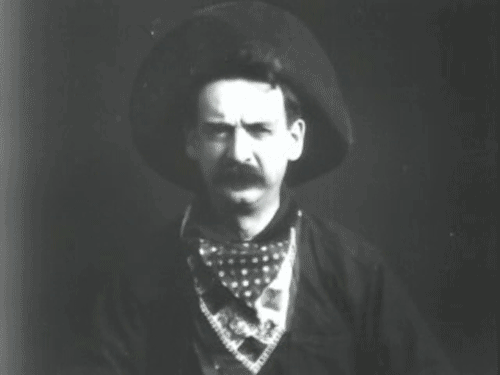
The Western arguably was born with the 1903 film, The Great Train Robbery. This 12-minute short film is a classic, and one of the earliest achievements in film-making. It’s also, unsurprisingly, a Western, and based on an actual train robbery. At the time it was made, the Wild West had only really ended a few years prior, with its heyday being about 40 years past. Which, yeah, is CRAZY. People who remembered the Wild West lived into the 1950s and ‘60s. It seems like so long ago, and it was, but it was still relatively recent from a historical standpoint.
From then, the Western remained a staple of cinema, and would be so for over half a century. And then, enter John Ford. Born in 1894, the Irish American director began his career in 1914 as an assistant and handyman, often working with his older brother Francis. Eventually, John took his place as a director, starting with silent films, especially westerns. Starting with the very successful film The Iron Horse in 1924, he quickly rose to stardom. He transitioned from silent films to talkies pretty effortlessly, and continued his streak. All the while, he was also one of the first directors to have a roster of actors in his company. You know how Tim Burton always uses Johnny Depp and Helena Bonham Carter? Or how the Coen Brothers always use Frances McDormand and John Goodman? Or Wes Andersen with Bill Murray and Owen Wilson? Yeah, that started with John Ford and...ugh...
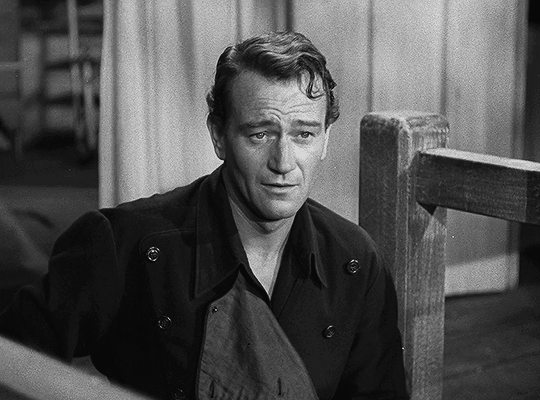
Before I start...fuck John Wayne.
Dude was a racist homophobic asshole, and absolutely a dick. Look it up, or don’t if you’d rather not have one of cinemas most iconic faces completely ruined for you. But OK, outside of that one time that he said that the Native Americans were “selfishly trying to keep the land for themselves”, or that he believed in white supremacy over uneducated blacks...yeah, he’s a DICK...
Marion Robert Morrison was born in Iowa in 1907, and began his film career after becoming injured while surfing without a surfboard and ending his football career. Yes, really. His football coach was a friend of a film director named John Ford, who hired Morrison as a favor to him. Said football coach was also friends with an actual remnant of the Old West: WYATT FUCKING EARP. YEAH.
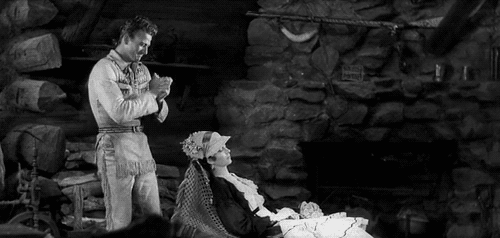
For years, Morrison was a bit player until starring in the film The Big Trail in 1930, a Western directed by Raoul Walsh. And he wasn’t exactly famous after this, but it was with this film that he took up a screen name: John Wayne, after a Revolutionary War general, Anthony Wayne, and...well, the name John. Anthony sounded too Italian. Yes, really. After this movie, Wayne continued to star in more Westerns, and even became one of the first film cowboys to sing on camera.
And then, 1939 came along, and John Ford came to him with a new film project. Being a classic Western, the film was about a group of settlers riding on a stagecoach together through the West. Strangers to each other, they find themselves attacked by a group of Native Americans belonging to the Apache tribes. This film, an adaptation of a 1939 short story, would come to be known as Stagecoach. And it would launch Ford, Wayne, and the Western genre into a Golden Age. So no more navel-gazing, let’s get started!
SPOILERS AHEAD!!!
Recap
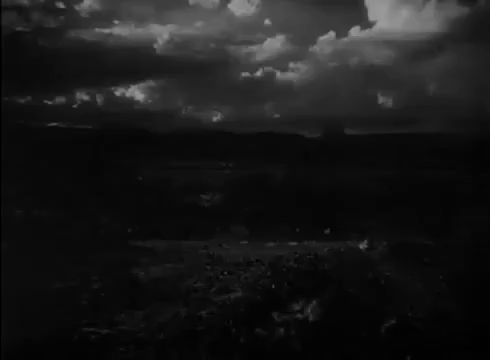
I get reminded that I haven’t watched a Criterion Collection film in a while, and the film begins with a rousing Western theme, courtesy of...holy shit, this movie has SEVEN COMPOSERS? Well, OK, courtesy of somebody in that list of seven. From there, we cut to a camp somewhere in the Arizona Territory in 1880. Which, again, is only 60 years prior to this film’s release date. There, a group of men discuss the danger imposed on them by the Apache, stirred up by the legendary warrior Geronimo.
And from there, we go to the town of Tonto, where stagecoach driver Buck (Andy Devine) lets a group of passengers out. One of these passengers is Lucy Mallory (Louise Platt), there to catch another shuttle to meet her husband in Dry Fork, New Mexico. However, the stagecoach gains an extra passenger in the form of the Marshal, Curley Wilcox (George Bancroft), who goes to find an outlaw also in Lordsburg.
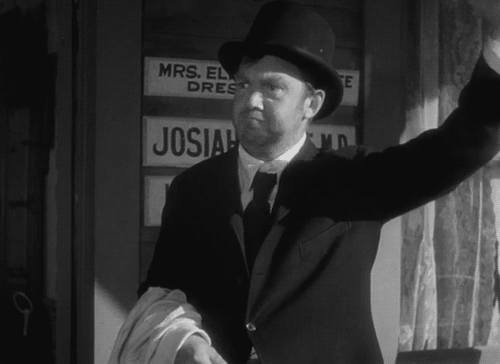
The passenger list builds with the addition of Doc Boone (Thomas Mitchell) and Dallas (Claire Trevor), a drunk and a prostitute both driven out of town by the Law and Order League of Women, due to social stigma affecting them both. In a bar getting a farewell drink, Doc meets yet one more passenger, Samuel Peacock (Donald Meek), a whiskey salesman that Doc is glad to meet. Meanwhile, banker Henry Gatewood (Berton Churchill) also boards the vehicle, under mysterious circumstances.
Friends of Lucy are worried with her travelling a drunk and a prostitute (the ABSOLUTE SCANDAL), but she needs to visit her husband in Dry Fork. As she leaves, she meets eyes with the dangerous but enigmatic gambler Hatfield (John Carradine). And before they’re able to leave altogether, the carriage is stopped by the army, who warn them of the Apache and Geronimo. All of the passengers refuse to get off, and YET TWO MORE passengers board to protect the carriage: the Marshal and Hatfield. And finally, they’re off! But as they head out, they’re stopped when they encounter a recently escaped outlaw.
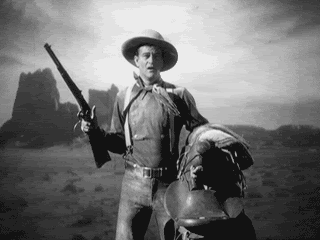
This is The Ringo Kid (John Wayne), who just got out of prison. The Marshal sees him, and takes him into custody on the way to Lordsburg, where they plan to drop him off into jail. And yes, he’s put on the fucking stagecoach. In total, we have Buck, the Marshal, Lucy, Hatfield, Doc, Peacock, Gatewood, and the Ringo Kid. Jesus, that’s a crowded-ass carriage, even if two of them are outside of it. Hell, Ringo’s sitting on the fuckin’ floor!
Anyway, the group interacts and introduces themselves. We learn that Doc once patched up Ringo’s brother, and was discharged from the Union Army for drunkenness. We learn that Hatfield is a true southern gentleman, and a veteran of the Confederate army (much to Doc’s ire), and that Ringo’s brother was murdered under mysterious circumstances.
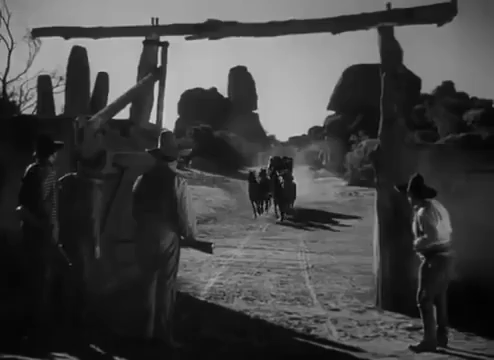
The group gets to Dry Forks, currently under occupation by the army. Said army had accompanied them (outside of the carriage, thank God) to Dry Forks, and are staying there to guard against the Apache. Meanwhile, Lucy’s dismayed to find that her husband isn’t in fact there. This leads to the debate of whether or not the party should go back to Tonto, or head onwards to Lordsburg. Buck wants to go back to Tonto, as does Peacock, while literally everybody else wants to go to Lordsburg. And so, they continue onwards.
Before heading onwards, the group sits for dinner, during which Ringo is the only one to show any form of kindness to Dallas, as everybody else looks down on her for prostitution. Shit, man, they won’t even sit near her at the table. Jesus. Unfortunately, Dallas is used to this cruel treatment, and it allows her to bond with Ringo in her loneliness. Once again, character interactions reveal things about our cast. Lucy is feeling quite ill, and Hatfield reveals that he served under her father in the Confederate Army.
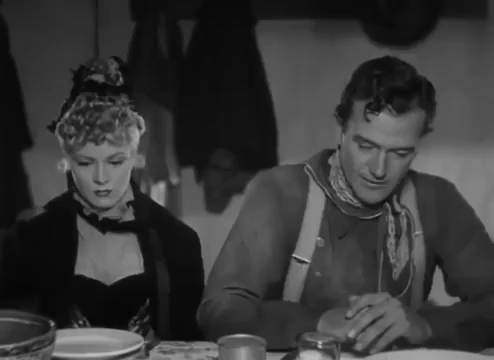
And from there, the coach continues on through the desert. Buck and the Marshal argue about letting Ringo free, as he aims to continue his feud with the outlaw Luke Plummer and his brothers, despite the fact that he’ll likely be killed by them. It’s for this reason that the Marshal wants to keep Ringo in his custody, as he was good friends with his father and doesn’t want to see him killed by the dangerous Plummers, whom Buck thinks should be taken down regardless.
Inside the coach, the banker reveals that he’s literally a Republican from 2016 (he rants about small government, and claims that a businessman should be President, holy shit), while people keep treating Dallas like shit, except for Ringo. They go through a cold mountain pass, which isn’t great for Lucy for some reason. It’s actually quite rough on everyone. Except for Doc Boone, who keeps drinking Peacock’s whiskey samples, which is hilarious.
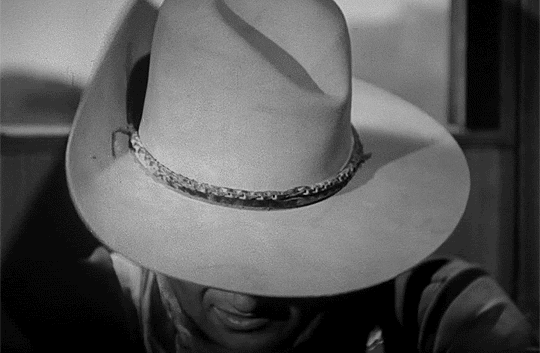
Finally, the group makes it to the next stop, Apache Wells. There, Lucy discovers that her husband has been severely wounded in a battle with the Apache, and she falls faint. Despite being absolutely SMASHED, Doc sobers up to help her, with the help of Ringo and the Marshal. Meanwhile, Dallas watches over her, despite the rancor that Lucy’s tossed at her this whole time.
The group stays the night, attended to by Chris (Chris Pin-Martin) a Mexican man who’s married to Yakima (Elvira Rios), an Apache woman who...is played by a Mexican singer. Huh. I mean...it’s still technically redface, unfortunately. But then again, the attitude towards Native American actors at this time was...oh boy. And the portrayal of the Mexicans in the camp aren’t exactly great, as a group of them steal the group’s spare horses, meaning that they only have one set of horses to use from here on out.
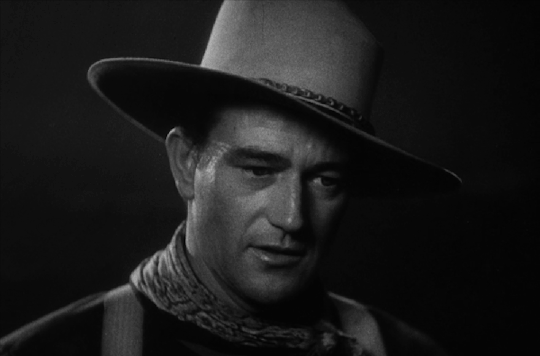
But amongst the unpleasant is a pleasant surprise, and the reveal of the cause for Lucy’s mysterious condition: she’s pregnant. Or rather, she was, as the baby’s just been delivered, and is being held by Dallas. As the group celebrates, Chris warns Ringo to stay away from Lordsburg, as the Plummers will kill him. But Ringo has something else on his mind.
See, on seeing Dallas with the baby, he finds himself quite in love with her. He finds her outside, and tells her that his father and brothers were killed by the Plummers. In turn, she reveals that her family was massacred on the real-life Superstition Mountain. Their conversation ends in Ringo proposing to Dallas, which she protests to because of her mysterious past.

The next morning, Yakima’s left with Chris’ horse and rifle, and the group worry that she’s gone to tell the Apache. After Gatewood panics about his mysterious valise being possibly stolen, the group packs up and readies themselves to go. But Lucy is, of course, still ill from literally giving birth hours ago. Things are still tense between Lucy and Dallas, despite Dallas taking care of her the entire fucking night. Jesus, lady, that high horse is looking uncomfortable, you should get off it.
Dallas has something else to worry about, as she’s thinking on Ringo’s proposal. She consults with the doctor, who reminds her of her mysterious and checkered past being revealed if she goes. But she doesn’t seem to care, and she decides to accept the proposal. As for the rest, Gatewood’s freakin’ the fuck out. Because of Lucy’s condition, the doctor requests that they don’t leave until a day later. And Gatewood doesn’t give a single shit, as the Apache are close enough. Still, the party decides to stay, at Hatfield’s added insistence.
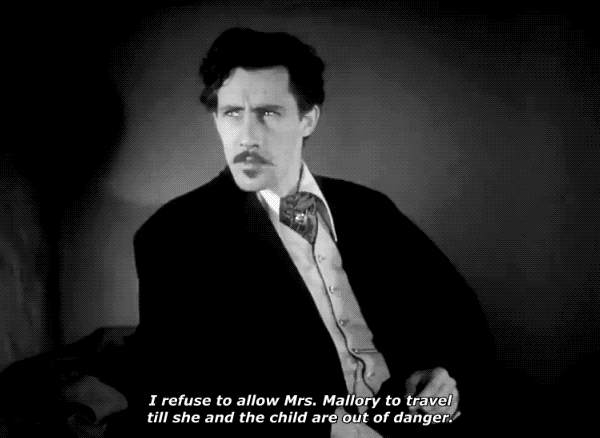
Ringo and Dallas talk, with Dallas both warning him of the Plummers, and also accepting his proposal. The men are all still arguing about whether or not they should leave, and they note that the Apache are likely between them and their destination. Ringo then takes the opportunity to escape and ride to Lordsburg for revenge on the Plummers. But he stops when he sees smoke signals on the hill. The Apache are coming.
No more waiting, it’s time to GO. Taking the still recovering lady and her newborn child Coyote into the stagecoach, they take off into the desert. Gatewood continues to run his loudmouth, to the ire of Hatfield and Ringo. And Peacock, to my delight, shows some kindness and “Christian charity” to Dallas, as she holds Coyote during the ride. And after all, they’re almost at the ferry!
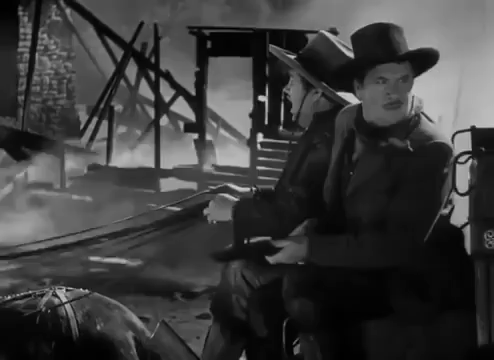
Ah, shit, the ferry! Looks like the ferry, and the entire town of Lee’s Ferry have been burned. And if they ford the river, all of their supplies could be flooded, or the oxen could drown! Or worse, dysentery could set in! That’s what The Oregon Trail taught me! And yet, despite this, that’s actually EXACTLY what they do! And unlike me literally every time I’ve every tried to cross a river without a ferry, they make it through fine! Realistic educational games my ASS!
But it’s not entirely safe, as the group are being watched by none other than the Apache, who make their way down to intercept the group. In the carriage, meanwhile, the group is thankful that they’ve made their way from danger, and even Gatewood relaxes a little. Doc Boone makes a toast, and everyone seems to be getting along for once.
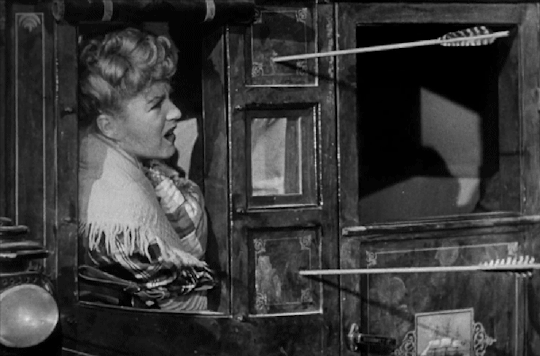
OH FUCK, PEACOCK GOT HIT!
The girlfriend IMMEDIATELY SAYS, “Now he really is Drew Peacock.” I leave and get boba to soothe my injured spirit from that well-timed joke. And then, the movie continues, and the chase is on! The Apache chase the stagecoach through the desert, and the groups trade gunshots and arrows, with Ringo shooting from the back. Gatewood panics so hard that Doc Boone punches him and IMMEDIATELY knocks him out, as he attends to Peacock’s injuries.
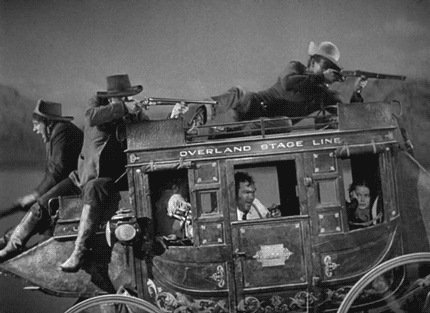
But despite their best efforts, the Apache group catches up to them, although many of them are killed by Ringo, the Marshal, Doc, and Hatfield. In the process, Buck is also shot, and Ringo literally jumps ON THE FUCKING HORSES, and commands them from the front like a goddamn badass. Things begin to get worse, as everybody in the stagecoach runs out of ammo, at the worst possible time. Hatfield only has one bullet remaining, and he considers using it...to kill Lucy! Holy fuck!
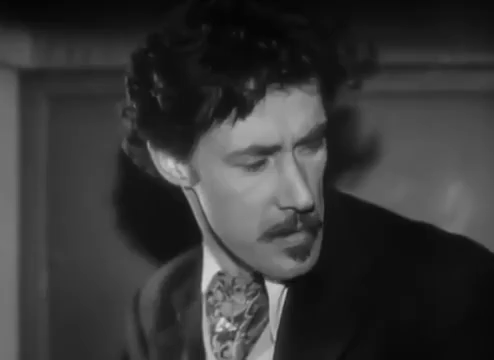
And just as he’s about to fire IN HER FUCKING FACE, the sounds of horns ring out as the cavalry arrives. And Hatfield, dick that he is, is shot. I think he was trying to spare her the indignity of being captured by the Apache, but Jesus, man! He collapses, and reveals that his father is a judge in Virginia before he...either passes out or dies, I’m not sure. The group finally gets to Lordsburg, where it turns out that Lucy’s husband is gonna be OK, and wasn’t severely injured. She tanks Dallas for everything that she’s done, and promises to help her should she ever need assistance. Good, finally, the lady needs a goddamn break.
The stagecoach rides through the busy town, and the arrival of the Ringo Kid gets the attention of Luke Plummer (Tom Tyler), who fetches his brothers Hank (Vester Pegg) and Ike (Joe Rickson). Time to get ready for a showdown, it seems. Dallas seems to know this, and goes to Ringo after the living Peacock (yay!) and the not-so-living Hatfield (oof) are brought in for medical help.
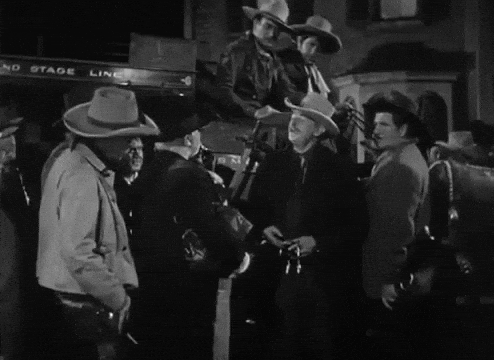
Buck’s also OK, but Gatewood isn’t. See, that valise he was carrying was actually full of money, and he had embezzled it from his own bank. He had counted on telegraph lines being down, so that he could escape with his ill-gotten gains, but has no such luck, and is led away in handcuffs! HA!
Ringo, meanwhile, is set to kill Luke Plummer and his brothers. The Marshal lets him escape, and promises to get Dallas safely down to a little ranch he owns in the South. Dallas and Ringo walk off together, and Dallas tries to get him to leave and say goodbye before he goes to his death, and before he finds out about her past (presumably as a prostitute).
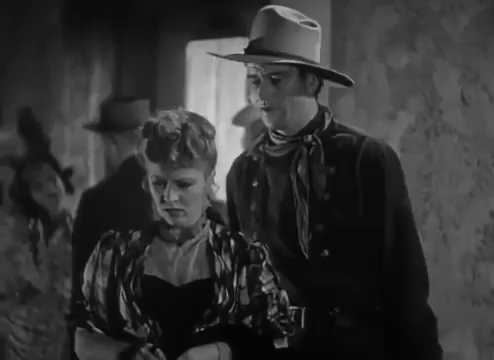
See, they’re actually walking up to a brothel, where Dallas is going to stay and work. Because, yeah, she’s a prostitute. Sucks that she’s been so maligned, because prostitution fuckin’ BUILT the Old West! I guess it’s easier to see that with historical context. As Ringo finds out the truth about Dallas (which he might’ve known all along), he still insists upon marrying her...and upon killing the Plummers.
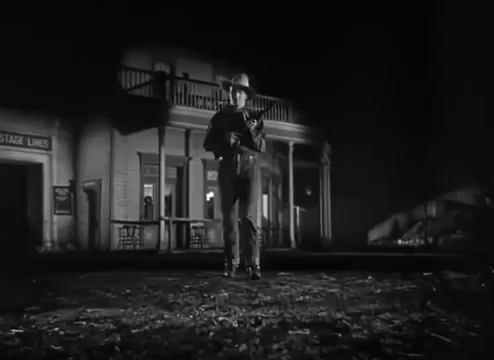
Doc, meanwhile, goes to the bar where the Plummers are waiting. He tells them that he’ll get them arrested, and Luke swears to come back for him after their business with Ringo is concluded. The brothers head outside, ready for the final showdown. It’s 3 on one, Plummers against Ringo. Ringo fires! A few more shots...then silence. And Dallas mourns.

Except that Ringo wins the fight, and goes back to her! A happy ending! I’m sure that’ll be pretty goddamn rare this month. The Marshal arrives to take Ringo away, and Ringo goes as promised. She asks to ride with him a bit, and the Marshal agrees. He and Doc watch them get on, then cause the horses of the carriage to stampede away, letting Ringo and Dallas escape into the desert, together. And that’s the end!

Y’know...I liked it! I really liked it!
This movie is often referred to as the greatest Western of all time, and the reason that the Western survived into the next several decades. And honestly, I get it! It was nominated for 7 Academy Awards, and won for Best Supporting Actor (Thomas Mitchell, AKA Doc) and Best Original Score, both of which were quite deserved!
Review time!
Cast and Acting - 9/10: Sure, it’s a little hokey. But at the same time, it’s good classic Hollywood acting! Wayne, Trevor, Mitchell, Carradine, and Devine are standouts for me, all of which serving their roles well. Also, fun fact about Andy Devine: he’s the voice of Friar Tuck in Disney’s Robin Hood! KNEW I recognized that voice!
Plot and Writing - 10/10: Standard plot? Sure. Engaging as hell? Hell yeah! This is just a good story, plain and simple. No holes, no problems, no mistakes, and purely straightforward. Great writing by the original story author, Ernest Haycox, and great screenplay by Dudley Nichols!
Directing and Cinematography - 10/10: Great looking movie, too! All credit to John Ford, unsurprisingly. Cinematographer Bert Glennon also deserves credit for the beautiful landscape shots throughout. Gogeous film, even in black-and-white!
Production and Art Design - 8/10: This is pretty standard Western production design, so not a lot to write home about specifically. However, that doesn’t mean it’s bad. To the contrary, it’s quite good! Just does stand out to me quite as much as other movies. Might be a nitpick, but it’s still something against the film.
Music and Editing - 10/10: No complaints! Seven composers definitely make their presence known, and you can tell that this score heavily informed all Western scores after it. It’s iconic, and it’s perfect for the mood. As for the editing by Otho Lovering and Dorothy Spencer...it’s great! Perfect pacing, well-edited...no complaints whatsoever.
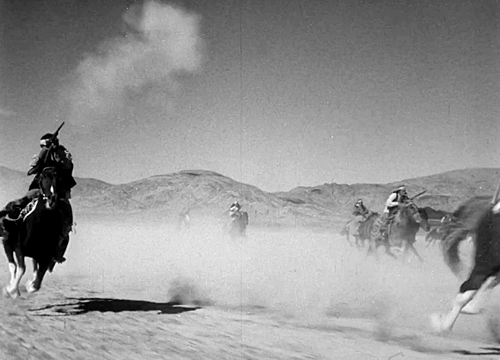
94%, and I had fun with this one!
I honestly did have quite a good time with this one. I can’t really call it a “fun” movie, but it definitely is a good one. Plus, it’s a John Ford/John Wayne film, which is basically a staple of the genre. So, what’s next?

Next: My Darling Clementine (1946), dir. John Ford
#stagecoach#stagecoach 1939#john ford#claire trevor#john wayne#andy devine#john carradine#thomas mitchell#george bancroft#apache#western august#365 days 365 movies#365 movie challenge#western genre#user365#usersasha#my gifs#mygifs
9 notes
·
View notes
Text
Examine the ways in which films deal with social, political, cultural, and economic issues, both in direct and indirect ways. What is the political impact of cinema on audiences around the world and how do we see it? Should filmmakers directly engage with these kinds of issues or do so subtly? Discuss any of the films we have watched so far from this perspective, and draw upon other examples if necessary.
Social commentary exists in many forms. We read it in books and hear it in music of every genre. It does not discriminate, covering every issue from politics to economics. As film grew into its own medium, it became a new platform for artists to utilize in portraying their visions of the world. Whether they be whimsical and over the top, or down to earth and stunningly realistic, movies grew to become one of the largest entertainment industries. Directors and screenwriters, whether inspired by or displeased with their surroundings, came to use film as a method of sharing their thoughts and emotions. Be it through direct or indirect means, they would criticize politicians and governments to historic and current world events. Certain countries were more limited than others in controlling the content of films, pushing creators to become even more crafty and thoughtful when conveying their opinions on screen.
With the Motion Picture Production Code in full effect in the US, film makers who wanted to touch upon political issues in American society had to do so in a very subtle way. Take Force of Evil, for instance. On the outside, it reads like a classic gangster movie that was commonly seen in the 1940’s. However, it is deeply critical of the money and power-hungry American underbelly of society, digging into the Capitalism that has overtaken the country even in these earlier years. Irony is found in the two main characters, a pair of brothers. Joe is a lawyer who runs dirty deals with gang members, using his education and career to further their unsavory deeds. His brother Leo believes that his own line of work is earnest and respectable, when in reality it is not. Leo runs a ‘bank’ for the small number rackets that exist in New York City, mainly centered around bets that are placed on horse races. Leo strongly feels that he is not as morally corrupted as his brother, despite being in charge of an illegal business.
The mise-an-scene of the film is what really drives home the underlying critique of money and its corrupting force. Joe takes Leo’s former secretary Doris for a walk on Wall Street, taking her through a church cemetery. The church building is completely dwarfed by the towering buildings of Wall Street’s capitalist businesses. The implied message here is that money is the new God, that the hold it has over people is nearly as strong as religion.
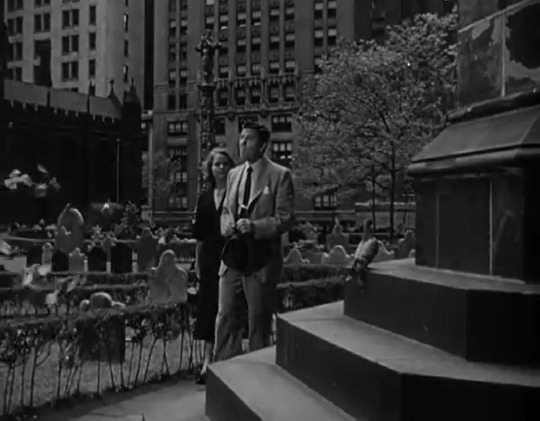
For Polonsky, who was put on the blacklist by HUACC for his leftist ideals, this message is as true to him as it gets. In Polonsky’s eyes, people no longer feared God as much as they did losing money in capitalist America. Considering what the entire world had just lost three years prior in World War Two, it is almost insulting to showcase people like Joe and his associates on screen. Money grubbing is not what America wanted its people to think they had fought and died for, just the opposite. Justice and morality is what America wants people to think it stands for, not capitalism and the desire to supersede the people in their lives. Force of Evil is astoundingly subtle and simultaneously gritty, holding true to the film noir standard of the times.
At the end of the film, when Leo is killed by Joe’s nefarious associates, Joe goes to retrieve his brother’s body. Stairwells are used as a metaphor for an internal moral struggle. In a voiceover, Joe laments ‘I just kept going down and down. It felt like I was going to the bottom of the world.’ The decrepit area beneath the bridge is the exact opposite of the organized, shining city above. Finding his brother’s body is Joe’s moral rock bottom, both literally and metaphorically. It is a slap in the face for Joe, stripping away all of the justifications he has held for his less than moral behavior and actions.
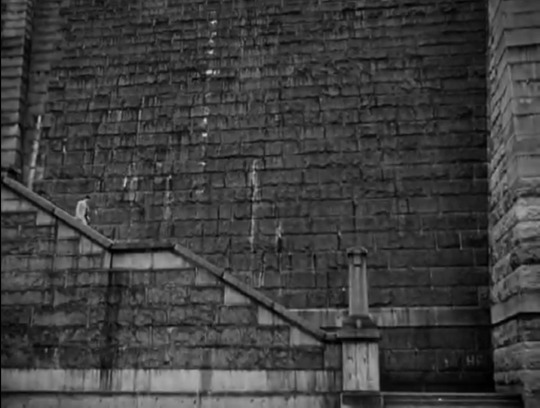
Polonsky cuts to Doris as Joe says, ‘He is dead,’ juxtaposing the image of a living woman with the realization that his brother Leo is gone. It is jarring, but it also suggests a dual motivation rising within Joe. Inspired by Doris’ love and Leo’s death, Joe turns to make his way back up the enormous staircase. This finale leaves the viewers with some hope that Joe can possibly redeem himself after his selfish actions, but will it be as quickly as he ran down the stairs towards his brother’s corpse?
One wouldn’t think that in 1950’s America, a bold film would tackle such a hot social issue: equal rights for African Americans. Especially with the Motion Picture Production Code still in full effect. Typically, when reflecting on movies from that decade, our minds are filled with images of romantic melodramas, as well as musicals and other bright, cheery content. The Defiant Ones not only tackled the issue of racism in America, but it also set the standard for the ‘buddy’ films that are commonplace today. Two escaped convicts are chained together at the wrist, one white and one African American. The film goes back and forth between Johnny and Cullen’s escapades whilst on the run, and the officers who have been assigned to track them down and take them back to prison. The tone of the film is established in the first few minutes, when one of the officers refers to Cullen as the n-word. Later on in the movie, when Johnny and Cullen are apprehended by a group of townspeople after attempting to rob their general store, they start stringing up two nooses. Johnny is mortified, looking around at the townsfolk with terror in his eyes. ‘You can’t lynch me, I’m a white man!’ he pleads. The message is clear: lynching is something white people do to black people.
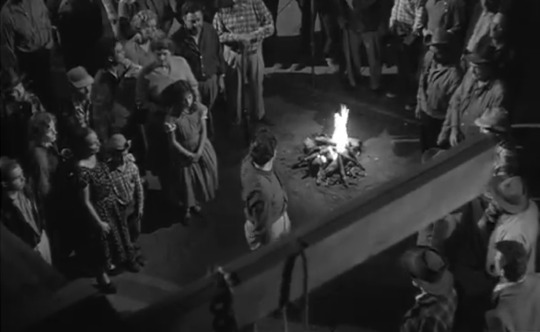
Not only does the movie look at the harsh reality of life for African Americans at the time, but the relationship that develops between Johnny and Cullen is in itself socially and politically charged. Over the course of the movie, the two convicts go from being at odds with one another to developing a close friendship. Not even Johnny’s mistake to trust the woman they holed up with can break their bond. Johnny leaves the woman behind to rescue Cullen from the dangerous swamps. At the film’s end, Cullen is cradling Johnny, who is wounded from a gunshot to the chest. They are collapsed on the grass together, sharing a cigarette while Cullen sings and the police detective approaches to apprehend them.
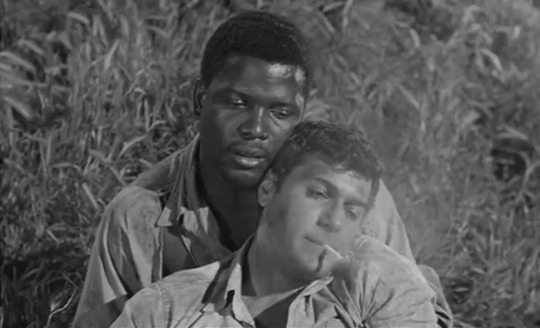
Not only has Johnny moved past his racist ideals, but one could also say that their positioning at the end of the film is borderline sexual. The way Cullen holds Johnny is almost as if it is in a lover’s embrace. Cullen’s portrayal in the film is especially bold, since he was portrayed to be well-spoken, intelligent and overall good. A far cry from films like Birth of a Nation where African Americans are put in the most negative light possible, portrayed as thieves and rapists while the Ku Klux Klan members are seen as heroic and noble. The Defiant Ones, supported by Sidney Poitier’s phenomenal acting, gave rise to a much more positive role for African American actors to portray on screen. Though the ‘righteous Black man’ did end up becoming a trope in Hollywood for many years, it was still a positive step in the right direction for civil rights.
Outside of the US, films were not constricted by strict standards of morality and content. They were much freer to openly criticize the societal norms and political atmospheres that were in place at the time of their creation. Hiroshima Mon Amour is a French made film that touches on the devastation of the nuclear bomb drops in Hiroshima and Nagasaki. While the movie itself seems to be mainly centered around a couple who cannot be together due to extenuating circumstances and their own inner demons, it is also direct commentary on how Japan remembered the bombings, and how different it is from the perspective of the rest of the world.
The first ten minutes of the film are composed of an almost poetry-like sequence of shots of Hiroshima before and after the bombs paired together with the two main character’s voice overs. The characters, a French woman, and a Japanese man, are in bed together in a loving embrace. The opening shot features ash falling onto their naked bodies, which we can infer mimics the death ash that fell onto Hiroshima after the atomic bomb’s detonation. This frame cross fades into nearly the same image of the naked couple, but the ash is gone from their bedroom.
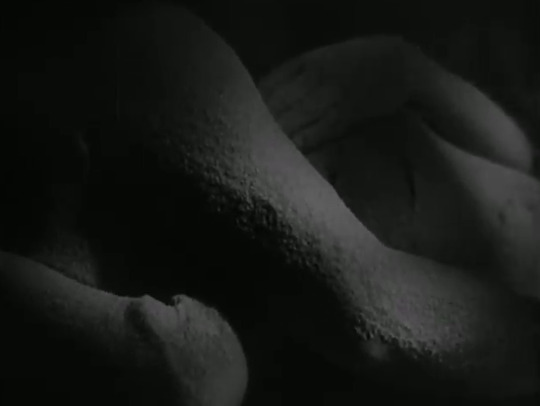
The woman is stating that she knows all about what happened in Hiroshima, from having seen the newsreels that aired after the bombs had been dropped. The man argues that she has no idea what really happened. She states that in the newsreels she viewed, bugs were already crawling up through the debris and dirt on the second day and that flowers were growing all over Hiroshima just a few days after the bomb had been dropped. This voiceover is paired with the footage of a young boy being treated for burns and lesions on his skin, the exact opposite of new life springing forth from the ashes. The obvious pain that the boy is enduring is starkly contrasted to how the French woman describes all the different kinds of flowers that began blooming after the bombs had been dropped.
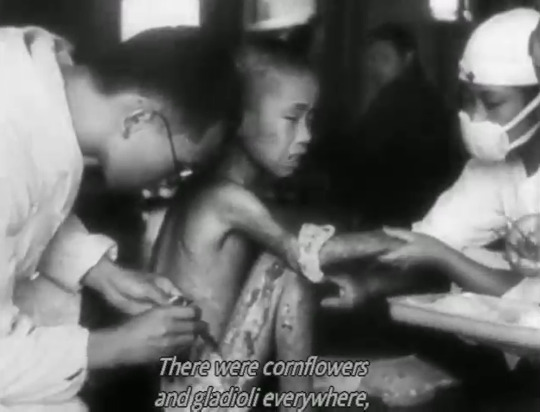
The Hiroshima that exists in the French woman’s mind is completely different from the Japanese man’s. This speaks to the overall theme of the movie, that collective and individual memories, as well as one’s identity can be corrupted. That the human brain is not a perfect organ and at times, it can even be our worst enemy. The French woman protests that she has seen Hiroshima. She had been to its museums, she knew how it had been over ten-thousand degrees in Peace Square at the time of detonation, and she had seen the films that had been made about the devastation. Her partner states over and over during this intro sequence that, ‘You saw nothing in Hiroshima. Nothing.’ Her experience of the disaster when compared to his is hollow, a clever way of illustrating how two people can think of the same event so differently.
Even if the trend of filmmaking has changed, shifting from film noir and melodrama to the blockbuster and action movies, social commentary still persists throughout the media. As the world around us changes and moves forward (be it for better or worse), so does the real-life content that directors and screenwriters are inspired by. Seeing politically and socially charged movies, whether they are extremely subtle or right up in your face, helps us both cope with world events and immortalize what occurred. As if to say, ‘We were here. We saw what took place. This is how we remember it.’
9 notes
·
View notes
Text
Cottagecore Films (pt. 5)
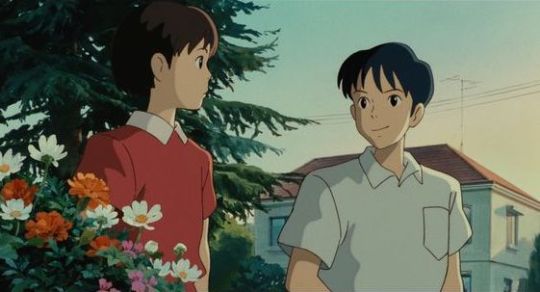
Whisper of the Heart (1995)
starring Honna Youko, Takahashi Issei, Kobayashi Keiju, Yamashita Yorie
Fourteen year old bookworm Tsukishima Shizuku has a goal of reading 20 books before school starts, but while she’s reading, she realizes that many of her books have the same name written on the library cards: Amasawa Seiji. She begins imagining who he might be, and evolves the idea into her potential prince charming. After school begins, she encounters a cat commuting on the train, and follows him to a quiet antique shop where she meets a kind elderly man, Nishi Shiro. She soon meets Nishi’s grandson, an aspiring violin maker, who she actually had an uncomfortable encounter with at school earlier on. The two of them become friends despite their differences, until Shizuku learns that his name is Amasawa Seiji, shattering her imaginary image of him. Despite her discomfort, they continue to bond and become close friends, even meeting at school, until Seiji has to leave for Italy for school. While he’s away, Shizuku vows to write a story for him to read upon his return, as an effort to become a better person and understand what she wants to do with her life. It’s a race to get her story onto paper before he returns, a race to plan for her future, and a race to understand what her true feelings are for Seiji before it becomes too late.
I have never seen a film capture the pure essence of middle schoolers like this one. It showed the discomfort of discovering love as young teenagers in a way that was realistic but wholesome and honest. Also if Shizuku wasn’t exactly how I was as a child I don’t know what to tell you. She had the unbridled determination and complete tunnel vision of a teenager who’s set her mind to something, and no amount of real-world obligations could deter her from her goal. Her imagination ran wild as she translated it to paper, and although she was proud for finishing it she was still unhappy with the ending, as any writer--especially a first time writer--would be on their first draft. The people she loved were real with her but encouraged her throughout, a fantastic representation of how blood family and found family can help form a young person’s character. 9/10
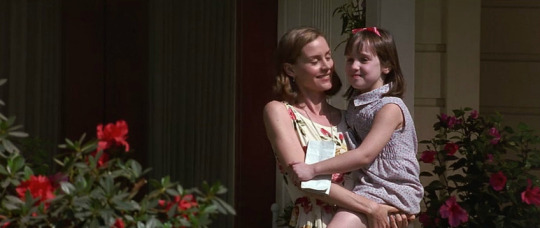
Matilda (1996)
starring Mara Wilson, Embeth Davidtz, Danny DeVito, Rhea Pearlman, Pam Ferris
Matilda is born to grouchy, rude, and dishonest parents, Harry and Zinnia Wormwood. They consistently neglect her as she grows up, so she learns how to care for herself early on. She develops a love for books and learning, and is thrilled when her parents finally allow her to begin school. However, the school she goes to is nothing like how she expected. Principal Trunchbull, a violent and hateful woman, runs the school through brutality and fear. On the other hand, Matilda’s teacher, the gentle and kind Miss Honey, teaches her children to love learning and supports each of them individually, creating a stark contrast of joy in her classroom to the terrifying rest of the school. Over time, Matilda learns that she has some unique powers, and begins using them to protect the people she loves and punish the people who abuse those around them. She creates her own form of justice for those who have never seen repercussions for their actions, and by the end her actions pave the way for a loving home.
I’ve watched this movie many times over the years, and I’ve loved it every time. It’s witty, sweet, entertaining, and endearing. The characters are very straightforwardly portrayed, and although they don’t necessarily have complexity, they don’t need it in a film like this. The main story is about Matilda growing and learning that she deserves to be happy despite the suffering she endured, and the film delivers on that perfectly. The characters are enjoyable--even the unlikable ones--and you can’t help but love to see Matilda exact retribution when the system can’t deliver it for her. Despite everything, she is still a kind and clever young girl, just as Miss Honey is a kind and empathetic woman, which are clear messages that I definitely needed as a child, and still smile upon as an adult. It’s a fantastic movie for all ages, and will always be worth the rewatch. 10/10

Mansfield Park (1999)
TW: detailed depictions of rape, abuse, and other violence toward people of color through drawings; slavery; racist language
starring Frances O’Connor, Hannah Taylor Gordon, Johnny Lee Miller, Alessandro Nivola, Embeth Davidtz, Harold Pinter, Victoria Hamilton, James Purefoy
Young Fanny Price, at age 10, is sent away from her impoverished family to live with her mother’s family, the Bertram’s, at Mansfield Park. There she meets Edmund, a boy of her own age and similar fascination with storytelling, and the two become best friends over the years. When Fanny reaches adulthood, Sir Thomas Bertrand and his eldest son move to Antigua, where the family maintains a plantation. Upon their departure, a new sibling duo, Henry and Mary Crawford, move into the parsonage nearby. Edmund quickly falls for Mary, and after a short bit of ingracious flirting on Henry’s part to one of Edmund’s sisters, he soon develops feelings for Fanny. When Fanny refuses his advances, however, Sir Thomas sends her back to live with her family, still stricken with poverty. However, Fanny doesn’t remain for long, when a family tragedy strikes Mansfield Park and she’s needed. There, she renews her friendship with Edmund, and several astonishing complications entwine their fates once more.
As with any Jane Austen story, I greatly enjoyed the characters. Fanny is incredibly headstrong and outspoken, but always uses it in the effort of kindness. I find Austen heroines to be excellent role models for young women, and that’s not the last time you’ll hear that from me, but this portrayal of the novel was particularly well acted. O’Connor’s portrayal of her is quick-tongued and cutting when she needs to be, but more importantly her voracity for life and love shines through in her acting. I found myself laughing at her witty comebacks to being slighted, and frustrated when her affections are unknowingly spurned time and again. Austen created a very empathetic and spirited character, but O’Connor expanded her into an even more relatable young woman. All of the acting was done very well, and the settings were both cozy and beautiful, even breathtaking at times.
I do want to make a comment regarding the trigger warnings here, given their graphic nature and how they affect my review. While I do feel that the detail depicted and the length of the scene were egregious, especially because they are never brought up again as a topic of contention, the drawings themselves were very realistic to the times. However, they are burned and disregarded in the film, and the character seen committing the abuses (Sir Thomas) does not face any consequences for them. It is a skippable scene (beginning when Fanny is looking through young Tom’s sketchbook), if such violence causes you discomfort. I personally was very disturbed as a person of color, not so much by the drawings themselves, although they were deeply unsettling, but by how Sir Thomas is never held accountable. He decides to stop being a plantation owner and takes up selling tobacco, implying that he no longer participates in slavery, but he doesn’t face any kind of backlash for it, even from his abolitionist family members. He has a happily ever after that he doesn’t deserve, and I know that is more distressing to many of us. As such, I must advise that you gain nothing in particular by watching these scene, and will lose none of the plot by skipping over it. 8/10
Part One // Part Two // Part Three // Part Four
#cottagecore#farmcore#cozycore#gardencore#grandmacore#period drama#studio ghibli#jane austen#film#film review#movie review#romance movie#movies#activities#mine
84 notes
·
View notes
Note
Hello there, I hope you have a great day! Also what are you thoughts about Tim Burton - Sweeney Todd’s movie adaptation? (Sorry thats pretty nowhere I just really appreciate u & Sweeney Todd very much 🥺💖)
Aww, thanks! Now, as for the 2007 Sweeney Todd... I hope I don’t get a lot of hate over this, but I had a lot of problems with this movie. I’ll try to go through this in organized chunks. I’ll put it under the cut, this is going to get long.
First off: the casting. We have to address the fact that, besides the actress playing Lucy, none of the cast really had any musical theatre experience, and it showed. This wouldn’t be as much of a problem if it weren’t for the fact that this was Sondheim music, which is insanely difficult, even for well-experienced musical theatre actors. Thus, we ended up with Sweeney awkwardly singing from his throat (sounding more like a pirate than Jack Sparrow) and frail, shrill vocals from Mrs. Lovett, Johanna, and Anthony. One justification that I’ve seen people use is “Well, Tim Burton was making a film, not a musical,” but in that case, why even include the music? Why not simply make a non-musical movie adaptation using those characters? Sweeney Todd has existed for far longer than the musical; the musical itself is based off of a play adaptation by Christopher Bond. It could have very easily been a movie adaptation of that play, instead. Moving past the singing, while this film did have a lot of really good actors, it wasn’t really any of their best works. I don’t know if it’s because of Tim Burton’s “style” or what, but a lot of the actors’ performances felt nearly lifeless compared to when they were in other movies (although Timothy Spall’s facial expressions as the Beadle were great!). Particularly, Helena Bonham Carter’s Lovett felt very flat and static. I feel bad for saying so, since this was apparently a dreamrole of hers (plus it was just her birthday yesterday!), but something about it just didn’t work. It seemed like she was torn between playing a doe-eyed damsel in distress, a jaded, sarcastic woman, and a suave, devious temptress (and being motherly for one scene, and the combination made for a bland and inconsistent performance. The inconsistency especially stands out during and after Epiphany, where she goes from looking quite terrified of Sweeney at the beginning to nonchalantly delivering the “That’s all very well...” line, even though the song got more scary towards the end, not less.
Now for what probably bugged me even more: some of the things that were cut. The film seems like it’s trying to be more edgy and gritty than the stage musical by cutting out some of the humor, but it also cuts out some of the darkest parts of the show. I can understand getting rid of the Greek chorus for the different Ballads of Sweeney Todd, but they really could have and should have included the ensemble bits for God, That’s Good. We can see the townspeople enjoying the pies, but it isn’t enough to see them simply enjoying the pies, we need them to be obsessed, screaming for “more hot pies.” Then there’s Toby, who doesn’t get his crazy part at the end. I understand cutting that bit short since we don’t have the final Ballad to end it (and therefore ending with the shot of Sweeney bleeding over his dead wife), but he could still do the creepy “pat-a-cake” stuff before slitting Sweeney’s throat and scuttling away. Besides creeping out the audience, this bit shows how everything has affected Toby and taken a toll on him.
And then there’s Johanna. Johanna, what did they do to you? Sometimes movie adaptations of musicals add some depth to some of the less-developed characters. Here, they seemed to do the opposite. She sings Green Finch and Linnet Bird, looks at Anthony, and after that only exists because the plot calls for her. Kiss Me is cut, which also cuts an entire plot point. She doesn’t even sing in the Johanna Reprise. It’s called the Johanna Quartet on the OBC album for a reason, guys! They not only reduced her to a prop who sings about her emotions once and no more, but her relationship with Anthony was also less developed. The two of them never really meet, they just look at each other once. That’s barely an interaction. It’s a wonder that she even recognizes him when he rescues her from the asylum. Speaking of, next came the thing that bothered me the most: she isn’t even the one to shoot Fogg (or whatever they named the asylum warden in this). In the musical, this was her moment of finally holding her own against one of the older male oppressors in her life. This was her breaking point, her loss of innocence she may not have even had in the first place. Changing this just felt wrong.
Alright, I’ve done enough ranting. There were a few things that I thought the film did pretty well, actually. Firstly, the cinematography. Tim Burton has a very specific aesthetic to his films, and this was no different. Some people like, it, others don’t, but the dark, muted aesthetic did work, in a way that may not have worked if another director did it. The opening sequence with an instrumental of the Ballad of Sweeney Todd playing looked really cool. I also especially liked the visuals during Epiphany, when Sweeney is outside having a mental breakdown as the crowds of townsfolk are completely unaware of his presence. While I didn’t care for his singing, Johnny Depp’s acting was pretty solid here. Sacha Baron Cohen as Pirelli was fun. The kid playing Toby had a good performance. I’m not usually a huge fan of children singing, but he handled the score well. Another thing I liked was the addition of the scene between Anthony and Turpin. It added an extra layer of vicious cruelty to the Judge that was more than just “creepy old guy preying after a teenage girl” (and the “You gandered at her” line was great, especially with Alan Rickman’s delivery).
All in all, I wasn’t really a fan of this adaptation, but there were some parts I did enjoy, and I appreciate that it did expose more people to Sondheim’s music and musicals in general.
9 notes
·
View notes
Text
Mortal Kombat Akademy
In between my work on the 31 Days of Original Characters challenge, I've begun to revisit my plans for the big Mortal Kombat story I'd wanted to do for awhile; Mortal Kombat Akademy. I've done a lot of character busts with backstory info and I did a sort of "season one" plots but this is something I'm not really satisfied with anymore. I'm gonna spend the new year trying to readjust and rework the overall story and characters to something more workable. Here's a few odds and ends of what I've planned so far;
Story Outline
Shaolin Monks, Lui Kang and Kung Lao, are recruited into the Mortal Kombat Akademy, the secret fighting school located on the island paradise of international crimelord, Shang Tsung. But those who step foot on the island are subjected to terrors beyond comprehension once they learn the true purpose of the school; a training ground for the soldiers of an interdimensional tyrant who conquers by use of a fighting tournaments ordained by the gods themselves. But one of the gods, Raiden, is willing to give Earth a fighting chance by training as many chosen Earthlings as he can so they may finally defeat the forces of evil in the Mortal Kombat tournament.
Kinda bare bones but for plot synopsis go, it helps me sort of make a launching pad for the ideas. Like my original idea, the story is still primarily about Lui Kang and Kung Lao going to the school and meeting/befriending the typical heroes of the Mortal Kombat world, Raiden being their mentor and Shang Tsung being the big bad to overcome.
But the story ideas I had just don’t really cut it for me now. I feel as though I was sort of putting the cart before the horse by putting so much time making elaborate details instead of snowballing one idea to make a big bright idea. I’ve made some titles for them;
Start the Semester!
Tour the Akademy!
Prepare for the First Exams!
Bond Like Your Lives Depend On It!
Learn the Fatalities!
Wills and Testaments!
Survive the Detetionrealm!
Survive the First Round of Exams!
Survive the Second Round of Exams!
Survive the Last Round of Exams!
Party Your Asses Off!
Mortal Kombat Akademy V. The DC Universe: Dawn of Pain!
To give some context to them, I had a storyarc planned; Early on, Raiden would want the Earthrealm class (the class would have Kang, Lao, Johnny, Sonya, Jax, Stryker and Nightwolf) to be friends and allies in order to survive the matches and save the world. Easier said than done when so many personalities were clashing together. And once they learn about fatalities, the class goes through some mental anguish over having to kill or be killed, Kang being the only one vowing to never kill anyone, to the disbelief of everyone else. Things start looking up once the class starts to trust and respect one another and become stronger fighters.
But Kano, on the behalf of Goro’s Class (Mileena, Kitana, Jade, Baraka, Sheeva, Skarlet, Reptile, Tanya and Kano himself) frames Sonya and Johnny for a crime, leading to Professor Quan Chi to exile them to the “Detention Realm” where his goons, Drahmin and Moloch, deal out the punishments. My idea for them that they’d be bumbling and dim so Johnny and Sonya could escape them, bonding while trying to make it to the final exams. Everyone but Kang and Lao have been defeated and since Sonya and Johnny were late, it’d all be up to them to beat Goro. Once Goro beast Lao half to death, Kang faces his fears and manages to defeat Goro without killing him, but not without making him suffer for all the pain he’s caused.
The class’ reward for passing the exams is an-all expense paid vacation to Edenia, which is basically a hellhole built to Shao Kahn’s pleasure. Here, Kang and Kitana get some alone time to romantically connect to one another during the celebratory feast hosted by Kitana and Mileena’s parents, Shao Kahn and Sindel. But really, the feast is for the Kahns to asses the threat that Raiden’s students hold to their long term plans. And finally, the DCU story is just a fun breather where I have the mid-1990s versions of their heroes (Superman with a mullet, Batman Forever styled Batman and the two Wonder Women, Artemis and Diana, for example).
And after rereading what I had for plots, I noticed how little the Lin Keui featured into the stories since I designed a lot of them for the series. Should try to fix that somehow.
Overall Art Style
As I stated in previous MKA concept art, I based the art style on the look of Steven Universe. I still intend for the project to be written fanfiction, but I do wish to have some elements of it to be drawn by myself. Not a full adaptation but maybe a full page illustration of each chapter, along with the general character/environment sketches, or like the ending credits of The Mandalorian series.
But back to the art style, I wish to change it. I can’t really go further on the style of Steven Universe if this story is going to be about such heavy violence and gore. It wouldn’t really look right, might cross over into unintentional hilarity or into the uncanny valley. I’m looking at something like the artist One, the man behind One Punch Man and Mob Psycho 100 whose style is really unique, fast, sketchy and frenetic, all attributes I think will work well. I also love the anime aesthetic of the 1990s so that’s definitely a goal to achieve since I’m setting the story in 1995.
Story Ideas To Keep
* Koins: My idea for an in-canon reason for the koins you win in matches (at least in Mks 9-11, IDK how far back they go) to unlock Krypt stuff will be used as a way for the students to buy things like food, clothing and resurrections due to being killed by another student’s fatalities since its primarily a learning facility instead of a battlefield. Though if you’re broke, you’re not gonna be saved. Koins, like in the games, will be given for performing a fatality and a moral choice comes up when you think “do I do good and be paid less, or do something terrible but get more chances of being resurrected if I die?”
*Profiles: I’ve got to do some rewrites for the characters. Nothing too too major since I do like a lot of what I wrote, but its more to streamline it to fit in the new direction I’m doing. Like, having Sonya, Jax and Stryker being Hall Monitors, I don’t think something like that is gonna be part of my story since I’m trying to take it a tad more seriously. The idea of Detention Realm and having Dharmin and Moloch as lovable henchmen is still canon, as far as I’m concerned. Think the two mice henchmen from the film “Flushed Away”. And on a final note, the newly retconned origin for Sindel...that shit isn’t gonna be part of my story.
Overall, whatever backstories that’ll be changed will likely be on a case by case basis. No telling who or what will be changed right now, but I’ve now thought of some parts to start with.
Diversity and Inclusion
This one is probably gonna be one of the hardest to accomplish since I really want to make the series really diverse with body types, genders and sexuality, race, neurodiversity, that type of subject matter. Inclusion is really important to me, and I’m scared how I might screw it up like how Disney, JK Rowling, SNL, Simpsons, Big Mouth, Voltron so many more screw it all up since they all serve the needs of the capitalist, neoliberal status quo over the voices of the marginalised.
And with that, brings up some more challenges. Will I make so many diverse original characters that they take time away from the canon characters? Should I make more canon MK characters differently diverse?
I'm also planning on having the characters display prejudices and bigotries but I'm scared I'll go in too much of "Bright" territory, if you know what I mean.
Tackling Mature Content
I mean, it goes without saying that the series is going to be full of violence and gore since that’s basically in the DNA of Mortal Kombat in the first place. But there’s much more serious topics I want to try to write. Like the effects of abuse, queer rights, the above themes about diversity and inclusion, the seemingly never ending war and the ideas of the long defeat. Of course, my chapters will be marked with as clear as possible content warnings, those are important.
A Shared Universe
A month ago, I watched a video about Midway trying to recreate the success of Mortal Kombat into other fighting games. The video, “Remember when Midway tried to copy Mortal Kombat?” talked about three would-be franchises of Midway fighting games; Mace: The Dark Age, War Gods and Bio FREAKS. After watching the video and reading about the games, I think it’d be good for lore if they were integrated into my story. Mace and War Gods could be used as part of the backstory of the series. Like the idea of the Earthrealm Kombatants being the descendants of the characters of Mace and War Gods, maybe Raiden was involved with the later, I’m not sure. Bio FREAKS could be latter used if I go into a time travel story. Maybe a mix of the game and the story/characters of Mortal Kombat X. As for Midway’s other successful but overlooked franchise, Killer Instinct, that is probably going to be the most recurring element in the shared universe. UltraTech, the main villains of the series would be the people behind such things as Kano’s cyborg eye, the Lin Keui’s Cyber Initiative and being the rulers of Neo-Amerika in the Bio FREAKS timeline. I also wrote in the profiles of Nightwolf and Sub-Zero that the Killer Instinct universe is linked to my story (one of his divorced parents is dating one of the parents of KI’s Black Eagle and Thunder while Glacius was an alien that helped give Cryomancers their powers).
And on a side note, there is another Midway MK clone called Primal Rage, which I swear I had one of the toys based on it and saw a parody of it on an episode of Dexter’s Laboratory. Its pretty gruesome, its a bunch of savage Kaiju in a post-apocalyptic earth that resembles the stone age. Probably an alternate timeline/dimension if I use it in my series. Who knows, maybe elements of the worlds of Street Fighter and or God of War could make an appearance...
Writing the Damned Thing
Probably the absolute hardest part of this entire thing. I struggle with actually keeping attention to writing since I’m primarily a visual artist and it feels terrible to not even follow through on any idea I have and it just kinda sits and collects dust in my brain. If its sketching and rendering, I can do it. If its writing shit down, I just have executive dysfunction when it comes to it. I never know where to start writing it, how to continue writing it, how to finish it or how to put it all together cohesively.
I can’t do this without at least writing the complete first season, if I do it on a semi-regular basis, nothing is going to be done. Even like, less than a week of non-recurring writing is like a poison to me. I don’t know how, but if I make room for an hour or two of writing a day every day might help me get more prepared for longer writing.
In Conclusion
When will the first chapter be done? I don’t know. When will I start writing? Hopefully as soon as I can. I can try to post updates or work in progresses, but that’s still a pipe dream, in my honest opinion. But I want to make progress in 2020, I need to make a difference and to actually make this coming year worthwhile.
#Mortal Kombat#mortalkombat fanart#mortal kombat fanfiction#mortal kombat liu kang#mortal kombat kung lao#mortal kombat raiden#mortal kombat kano#mortal kombat shang tsung#mortal kombat johnny cage#mortal kombat sonya blade#fanfiction#story outline#workinprogress#wip#art WIP#artists on twitter#artists on tumblr#classic anime#steven universe#mob psycho 100#god writing is hard
10 notes
·
View notes
Text
Conan: Ranking the Best Remote Segments
https://ift.tt/eA8V8J
WarnerMedia announced on Tuesday that Conan O’Brien’s long-running TBS talk show, Conan, would be coming to an end next summer. Thankfully, however, the late night pioneer isn’t leaving television altogether – just trading the network world for the streaming one. In addition to his Conan Without Borders travel series already airing on TBS, O’Brien will produce a new weekly variety show for WarnerMedia’s streaming platform, HBO Max, to premiere at a yet-to-be announced date.
“In 1993 Johnny Carson gave me the best advice of my career: ‘As soon as possible, get to a streaming platform,’” O’Brien said in a statement. “I’m thrilled that I get to continue doing whatever the hell it is I do on HBO Max, and I look forward to a free subscription.”
At first glance, this appears to be bittersweet news. O’Brien has been a late night talk show staple for decades. Following an excellent writing career for The Simpsons and Saturday Night Live, O’Brien took over for his hero David Letterman on NBC’s Late Night in 1993 and stewarded it through 2009. That was followed by a measly half-year as host of the venerable Tonight Show before NBC got spooked about not having Jay Leno on TV anymore. For the past 10 years, O’Brien has continued his late night talk show format for TBS’s Conan.
Though it’s sad to lose O’Brien as a late night talk show titan, the reality is that the comedian was never much of a talk show host to begin with. That’s not to say that he wasn’t good at the job, because he was. But it’s always been evidently clear that O’Brien succeeds the most when not tied to the restrictive talk show format. This is something that the host himself has increasingly realized over the years, cutting out an interview segment slot from Conan to bring the running time down to a breezy 30 minutes, and producing the acclaimed Conan Without Borders series to capitalize on his already popular remote travel segments
The best comedy that O’Brien has throughout his impressive run has very rarely been delivered in-studio. Every time O’Brien left the confines of his desk, whether it be for Late Night, The Tonight Show, or Conan, viewers could be confident that they were about to witness something truly hilarious. The longtime comedy writer quite simply thrives being out “in the wild.” There he is able to put his gangly comedic physicality to use and truly relish his ability to make people uncomfortable.
In honor of O’Brien finally making the long-awaited jump back to variety comedy, we’ve gathered together our 10 favorite remote segments the comedian has ever done. The only qualifications here are that the bits have to have occurred on one of his three major shows and they have to feature him away from his studio. Also, we won’t be counting any official Conan Without Borders entries as that is a distinct entity and would muddy the waters too much.
Without further ado…
Honorable Mention – Triumph the Insult Comic Dog Attends the Premiere of “Star Wars: Attack Of The Clones”
(Original airdate: 5/17/2002)
Sadly, Triumph the Insult Comic Dog is not Conan O’Brien and therefore cannot appear on this list of Conan’s best remote segments. But it would feel unfair not to take time to highlight Late Night with Conan O’Brien’s other remote segment superstar. As created by SNL’s Robert Smigel, Triumph is a Eastern European-accented, cigar-chomping insult comic…who also just happens to be a dog puppet. Triumph’s trips outside the studio are almost always hilarious, but the rude canine hits an absolute comedic high with his trip to the Attack of the Clones premiere. Perhaps the most amazing thing in that clip isn’t the numerous cutting, hilarious, and utterly cruel nerd jokes, but how rapturously the audience responds at the beginning upon learning that Triumph is the correspondent Conan sent to the premiere.
10. Conan’s Trip to Ireland
(Original airdate: 3/17/1999)
Here, as far back as the 20th Century (before “the year two-thousaaaanddd”) we can see Conan began to realize how much fun he, and his audience by extension, had when he hits the road. Sending a red-haired individual named Conan O’Brien to Ireland is about as easy a slam dunk that a late night comedy writer can find. There’s a lot to love here, but nothing will top the photoshopped portraits of all of Conan’s ancestors.
9. Conan Delivers Chinese Food in NYC
(Original airdate: 11/1/2011)
Late in 2011, just under a year after Conan premiered, Conan returned to New York City where he had spent his Late Night tenure to film a week’s worth of shows. And what better way to ring in the return than with a stellar remote segment? In this bit, Conan serves as an inept delivery boy for Manhattan Chinese restaurant King Wok. It’s apparent early on just how excited he is to be back in New York when he’s already purring at one of the employees 10 seconds in. Conan gets the full New York experience in this, from one standoffish deliveree angrily denying that he’s her delivery guy to him being served Argentinian tea from a beautiful woman leaning out her window. The citizens of New York City are often Conan’s best comedic collaborators and they show why once again here.
8. Conan Goes to Trucking School
(Original airdate: 7/18/1997)
“Conan Goes to Trucking School” benefits from having the thinnest of setups. Conan wants to be a truck driver. Why? Well, who cares, the Jersey Truck Driving School is up for it and we’ve got some time to kill. Into that conceptual vacuum steps Conan just having the time of his life. You know you’re in for a good remote segment when Conan and a trucker he just met are singing a country song less than two minutes in.
7. Conan Tries to Sell His Ford Taurus
(Original airdate: 5/6/2004)
Conan O’Brien’s reviled puke green 1992 Ford Taurus is one of Late Night’s most enduring non-human characters (right up there with the Masturbating Bear). This segment serves as the first time we get to see the damnable machine in the chrome and it doesn’t disappoint. “Conan Tries to Sell His Ford Taurus” is among the best Conan remotes ever because it’s pretty clear that Conan actually loves the stupid thing. Of course he’s joking when he says things like “the wolf is on the prowl” or calls his stick shift the “Cone Bone”, but he doesn’t have to fake much pain when car experts give in an assessment in the $1800-3000 range.
6. Conan Visits The American Girl Store
(Original airdate: 12/18/2013)
“Conan Visits The American Girl Store” is perhaps the best argument you can find for giving Conan O’Brien alcohol and putting him on television. The first half of this bit is undoubtedly solid as Conan plays up the creepiness of him visiting a store designed for young girls. But things really take off when he finally chooses his doll (Potential Nazi war criminal Agnes Schweitzhoffer) and settles in for dinner in the American Girl Store’s shockingly lush dining room. As the chardonnay goes down, Conan (and Agnes by extension) are increasingly unable to hide their annoyance at the garçon and all his stupid riddles.
5. Conan Goes to Houston to Find Viewers
(Original air date: 5/1/1997)
In the first few years of Late Night with Conan O’Brien’s run, Conan and his team of writers had plenty of fun with how little people seemed to enjoy their dumb show. This segment takes that concept to its extreme. When Conan discovers that the Houston television market doesn’t air Late Night until 2:40 a.m. local time, he takes a camera team to Texas to find some fans after hours. The journey takes him from a bail bonds office, to a hotel basement, to an emergency room, and all the way to a bus terminal at 3:21 a.m. where he meets a man who is decidedly not a fan. “I was just almost murdered,” Conan says as he sits down for comedic effect…but also probably to catch his breath.
4. Ice Cube, Kevin Hart, and Conan Share a Lyft Car
(Original airdate: 12/10/2013)
The apparent success of Conan’s remote segments can be charted over the years by the level of talent that wants to get in on them. In this segment, Ice Cube and Kevin Hart are unambiguously big gets. And instead of any studio nonsense, they were more than happy in 2013 to check out this strange new service known as…Lyft? Are we pronouncing that right? Something about getting Conan, Cube, Kevin, and their Lyft driver Anthony in an enclosed space brings out the madness in them all. Hart and Ice Cube have a blast trying to turn Anthony against the gangly Conan as he runs into 7/11 to get everyone swisher sweets and a DVD of Ghosts of Girlfriends Past. Highlights here include Conan’s absurdly burdensome beatboxing and Kevin yelling “I’ll cut his shins off!” to Anthony’s friend over the phone.
3. Conan Plays Old-Timey Baseball
(Original airdate: 6/25/2004)
When Conan signed off of Late Night for what would be an unexpectedly brief Tonight Show tenure, he brought back this 2004 skit as an example of the kind of absurdist humor he felt the show did best. And it’s clear to see why. Conan’s trip to Old Bethpage Village Restoration where reenactors play old-timey baseball is in many ways the goofy platonic ideal of a Conan segment. The absurdity of the premise is funny enough as is, and then Conan’s buy-in only enhances the proceedings. “What is that demonry???” a 19th century Conan cries as a plane passes overhead. But the not-so-stealthy MVP here is the reenactor who is truly committed to her role as the dour village woman with a dead father and a soon-to-be-dead husband in the Civil War. “You know that guy ain’t coming back. I was down in the Civil War. I saw him and he was acting very cowardly I have to say,” Conan says in an attempt to woo her.
2. Dave Franco and Conan Join Tinder
(Original airdate: 7/17/2014)
Just about every moment of “Dave Franco and Conan Join Tinder” is joyously, ludicrously hilarious. Conan gives viewers all the set up they need for why he’d want to browse Tinder with Dave Franco, saying “Naturally, because I’m a creep, I’m intrigued.” Conan and Dave adopting their Chip Whitley and Dgenghis Roundstone (the “D” is silent) personas is wonderful. As is an unexpected cameo from Conan’s assistant Sona and Conan and Dave’s competition over the 74-year-old Gloria. But per usual, this thing really gets moving when Conan and Dave hit the road in their creepy panel van. Conan assures Dave that the van is filled with duct tape solely to hold the cameras up. “I wish I could say I saw duct tape on any of these cameras,” Dave responds. Once Chip and Dgenghis finally meet their Tinder date, this segment evolves into its glorious final form where Dave and the citizens of L.A. bond over what a weirdo Conan is.
1. The Jordan Schlansky Saga
(Original airdate: 9/1/2008)
Our number 1 entry is a bit of a cheat. For starters, this is not referring to merely one remote segment but a whole genre of them. And the first entry is not even technically a “remote.” Still, we must highlight it all the same for the saga of Conan O’Brien’s associate producer Jordan Schlansky is among the best comedy that Late Night/Tonight Show/Conan ever produced. During the writer’s strike in 2008, Conan tried to keep Late Night going without his usual bevy of writers to help out. This meant segments in which Conan would meet with some of the people behind the scenes of his show which brought him into contact with his eventual archnemesis Jordan Schlansky.
Schlansky is just an aggressively strange person. Always dispassionate and rarely smiling, Schlansky fancies himself a Bohemian renaissance man with his breakfast shakes, mastery of the bullwhip, and vespa. The best part of their original meeting is when Conan realizes just how hilariously bizarre the gestalt of Jordan and can’t help but collapse into laughter as he chokes out “You’re just not like other people.” Later Jordan would join Conan and many remote segments to aggressively annoy and vex him, including one dinner that is among the best things the show has ever done. That lead to Conan’s truly chilling villain monologue:
Conan: I promise you this, I will not kill you myself. But I will have you killed. I will have you wiped out.
Jordan: I am subject to the same winds, the sun, the air that created the wine that I am drinking.
Conan: There will be nothing that links me to your murder. There will be no physical link between your dead body and myself. But you will be murdered. I will order it. I will pay for it. But I’ll have no- I am blameless in the eyes of the international court, that I promise you. (laughs) I’m gonna kill you. (laughs) You have to go.
cnx.cmd.push(function() { cnx({ playerId: "106e33c0-3911-473c-b599-b1426db57530", }).render("0270c398a82f44f49c23c16122516796"); });
BONUS – Conan Checks Out the Christmas Lights in Dyker Heights
(Original airdate: 12/22/2000)
Here’s a bonus entry for purely sentimental reasons. This is nowhere near the best of Conan’s hundreds of remote segments, but it holds some personal value to your dear author. Once upon a time I was a child celebrating the Christmas season a month after my family’s 400-mile move to a new home. My parents had a Christmas party that day and I severely overindulged on chocolates, finishing them off with several clementines before bed for some reason. Suffice it to say, sometime around midnight, I puked all over a brand new sleeping bag I received as a gift and ended up on the couch, full of chocolate, clementines, and regret. My mom flipped on the TV to distract me while she hauled off the sleeping bag to be cleaned…or burned. On TV was this very segment “Conan Checks Out the Christmas Lights in Dyker Heights.” I was enraptured by this strange orange-haired man making fun of people’s garish Christmas decorations…even as I tasted the foul acidy sting of rancid citrus in my throat. And thus is the perfect Conan O’Brien watching experience. Best of luck at HBO Max, Conesy!
The post Conan: Ranking the Best Remote Segments appeared first on Den of Geek.
from Den of Geek https://ift.tt/32VUxBG
1 note
·
View note
Note
Hey~ how are you today? ☺️ may I get a ship please? I'm 18 years old,small, petite, shy, random, giggly, sarcastic, bright, and clumsy. I have green eyes, red hair, wears glasses, and I have freckles. I love writing, animals, movies, music, playing instruments, and being with my friends and family. I'm really quiet at school/ around strangers but I'm much more outgoing when I'm with my friends. I'm very protective of my friends and family. I can be a little scary when I'm mad too. 😅 Thank you~!
hi! i’m doing alright, thanks so much for asking!! of course you can get a ship and i cannot apologise enough for responding so late! anyway, lets get this ship sailin’
i think you and johnny are DESTINED. i can also kinda see you with pony or soda or even darry, but i think johnny would appreciate your qualities the most. he LOVES how petite and adorable you are! he especially loves holding your small frame and it makes him feel more masculine and dominant. he’s constantly getting completely lost in your green eyes and running his fingers through your gorgeous red locks (he adores both, mostly because he finds them both extremely breath-taking, unqiue, and interesting features!) when you two cuddle or even simply hug.he loves cracking jokes with you and he’s one of those people who laughs even harder because you laughed too. he likes that your intelligent and quite frankly, he brags about it pretty often. he’ll walk around town and you’ll say something witty or share some obscure but smart fact and he’ll be like ‘yup, that’s my girl. the brightest you’ll ever know!!” and you help him out so much at school and he’s so grateful :’) you both are the ultimate shy/clumsy rocket duo and you both always make the gang laugh. for example, one fateful evening, you and johnny were standing and talking and laughing, the usual. pony ran into the living room and called your name to ask you a question about a film he had recently saw and you had read the book to it. anyway, as pony grabbed your attention, johnny was in the process of leaning in and before you knew it, you were sprawled on the floor with johnny on top of you and his face immediately turned a deep shade of red out of pure embarrassment. pony just laughed his ass off and two-bit soon joined. dally actually helped you both back up and asked the two of you if you were okay - while laughing hysterically. you and johnny still laugh about it to this day too, and it commonly comes up randomly. anywayyyyy,,, you are SO CREATIVE and he L O V E S that!! he cant get enough of you, seriously. you’re literally so perfect in his eyes. he loves watching you write and just takes in how beautiful you look. he sees you as a goddess, with the sunlight from the fairly small window making your face glow even more, and the focused expression on your face makes that poor boy S W O O N! and he always encourages you to read your work to him, whether its finished or not. he’s so convinced your a bestselling author writing under a pseudonym and you’re extra determined to keep your identity, even from him. and sometimes he’ll even give a few suggestions and ideas! he also enjoys taking ou out to the movies whenever possible, even if it means spending the last few dollars he has. he’s willing to give everything and anything up for you because he adores you just that much and he insists more too. AND DONT EVEN GET ME STARTED WITH MUSIC THIS BOY IS A LOW KEY MUSICAL GENIUS AND HE LOVES MUSIC SO MUCH!! you gave him your old guitar and taught him some chords and hE W R O T E A S O N G F O R Y O U A N D P U T T H E C H O R D S T O G E T H E R A N D E V E R Y T H I N G!! and of course you enjoyed every moment of it, even though you could tell he was pretty nervous and maybe a little embarrassed afterwards too because he THINKS he cant sing but he actually CAN and the slight rasp in his voice literally kills you. also, you two tried starting a band but johnny quickly dropped the project because it made him nervous performing in front of others (yup, even you). last but not least, we can NOT leave johnny’s family situation out. he stopped sleeping at the curtis’s house so frequently and basically moved into your house. because of your strong bond and relationship with your family, they were more than welcome to let him stay and they were quite infuriated by his household situation. your parents wanted to do something about it but you told them its better if they leave it be. the last thing johnny needed was more trouble with his folks, and your parents reluctantly accepted it. he thinks it’s amazing how protective and defensive you are of your friends and families and he truly admires that. you’re friends and family absolutely love johnny and let him in pretty quickly. also, you could gradually see johnny coming out of his shell more and he became more outgoing and just overall happier like he used to be.
BONUS! :
- one time he brought home a stray dog and the following week, he brought home a cat!
- he loves putting finger smudges on your glasses because he thinks its funny when you can’t see and you hate it
- talking about hate and anger, this kid bakes for you when you’re in a bad mood and he literally calls you hot sauce when you get all mad and feisty (he thinks you’re really hot when you’re mad because he’s a boy and,,, well,,, he finds it hot lmao)
- his favourite thing to bake for you are dinosaur cut-out chocolate chip cookies and its referred to as his “special dessert”
- okay so johnny was feeling clever and bored, so as soon as you fell asleep on the couch right next to him, he shimmied out of his spot and sneaked into pony’s room for a marker, any marker, and literally connected some of your freckles into the shape of an elephant and when you finally woke up, this boy could not. stop. laughing. and you were so confused for the longest time until dally came in and pointed out the rather unusual drawing lmao
- he also did that like twice and obviously you were gonna get your revenge… kekekeke
7 notes
·
View notes
Text
Home Entertainment Consumer Guide: May 10, 2018
8 NEW TO NETFLIX
"Amelie" "Beautiful Girls" "Faces Places" "God's Own Country" "Red Dragon" "Scream 2" "Shrek" "Sliding Doors"
8 NEW TO BLU-RAY/DVD
"All the Money in the World"
Ridley Scott made two films in 2017 and neither really got the attention they deserved. He's one of our most consistent living craftsmen, a man who makes the difficult art of filmmaking look easy. His telling of the story of the kidnapping of John Paul Getty III was one of those films for which the making of the movie became more enticing than the project itself. It started with the recasting of Kevin Spacey with eventual Oscar nominee Christopher Plummer but continued with the pay disparity between stars Michelle Williams and Mark Wahlberg. Now that the noise around the film has quieted down, you can watch it for yourself and decide how it fits in the history of Ridley Scott's career, one that shows no sign of slowing down even as he enters his eighties.
Buy it here
Special Features Eight Deleted Scenes "Ridley Scott: Crafting a Historical Thriller" – Director Ridley Scott and the cast and crew discuss the fast-paced and exciting way he filmed this epic movie. "Hostages to Fortune: The Cast" – A look into the award-winning actors and their connections to their real-world characters. "Recast, Reshot, Reclaimed" – This piece follows the unprecedented recasting of the character J. Paul Getty a little over a month before the film's theatrical release.
"Dead Man" (Criterion)
Jim Jarmusch is one of my favorite filmmakers even if his beloved postmodern western with Johnny Depp was never a film that really worked for me. It seems like Roger had a similar love-hate relationship with Jarmusch over his career, giving him plenty of positive reviews, including four stars for "Mystery Train" and "Broken Flowers," while also hating "The Limits of Control" and this film, which he gave only a star and a half. When I saw it for the first time, I felt similarly to Roger in that Jarmusch's approach felt more half-baked than the deep philosophy some see in this project. Being given the chance to revisit the film by Criterion, I'm now somewhere between Roger's original opinion and those who adore "Dead Man," able to appreciate how it fits into Jamrusch's career but still not completely won over. However, this is a great edition for those of you that are. Maybe I'll join you in another twenty years.
Buy it here
Special Features New 4K digital restoration, supervised and approved by director Jim Jarmusch, with 2.0 surround DTS-HD Master Audio soundtrack New Q&A in which Jarmusch responds to questions sent in by fans Rarely seen footage of Neil Young composing and performing the film’s score New interview with actor Gary Farmer New readings of William Blake poems by members of the cast, including Mili Avital, Alfred Molina, and Iggy Pop New selected-scene audio commentary by production designer Bob Ziembicki and sound mixer Drew Kunin Deleted scenes Jarmusch’s location scouting photos PLUS: Essays by film critic Amy Taubin and music journalist Ben Ratliff
"Den of Thieves"
Before the release of his latest action film, a few critics were discussing the career of Gerard Butler, and trying to find the highlights. The funny thing is that he's always been an actor I relatively liked, but he picks BAD projects, from "The Ugly Truth" to "The Bounty Hunter" to "Geostorm." It feels like he's struggled to find what's next but he really works as a cop on the edge in the relatively smart and tense "Den of Thieves," a movie that's been compared to "Heat" because of its plot and length. Even if it doesn't have nearly the depth of that Michael Mann classic, it's a better movie than its release date may have suggested to you, anchored by good work from Butler and O'Shea Jackson Jr. It's WAY too long, but it's the kind of thing that's easy to watch at home, and lands nicely with a twist that I honestly didn't see coming. It's the kind of thing I expect will play on basic cable channels like TNT for the next twenty years.
Buy it here
Special Features Alternate Ending Alpha Males – The cast describes how the tough characters in the film blur the lines between the good guys and the bad guys. Into the Den – Director Christian Gudegast and the cast describe the two brotherhoods within the film, the renegades and the outlaws, and their unique sets of skills. Alameda Corridor – The cast and director discuss filming the intense scene that take place on the streets of L.A. and the extensive weapons training it took to film it. Outtakes and Deleted Scenes Audio Commentary with Director Christian Gudegast and Producer Tucker Tooley Den of Thieves Theatrical Cut
"Hostiles"
One of the more interesting business stories out of TIFF this year was this high-priced western from the director of "Crazy Heart" and "Out of the Furnace." Most critics and potential distributors seemed to agree that it was solid enough to warrant an awards season run, especially for the very-good Christian Bale, but the film cost way more than most companies were willing to pay for it. What happens when the Oscar bait is too expensive for studios who win Oscars? That may be too inside baseball for those of you just looking for whether or not you should rent or buy this, so I'll just offer a mild recommendation. The performances are excellent throughout and Cooper has a good sense of the genre, but it's too long and takes itself way too seriously to really register outside of hardcore western fans. Maybe that's the real reason it took so long to sell.
Buy it here
Special Features "A Journey to the Soul: The Making of Hostiles" 3-Part Documentary -"Provenance" Featurette -"Removing the Binds" Featurette -"Don't Look Back" Featurette
"Mary and the Witch's Flower"
Studio Ponoc's first film is based on "The Little Broomstick" by Mary Stewart and directed by Hiromasa Yonebayashi, who helmed the excellent "When Marnie Was There." As companies like Ponoc try to usher in the era of Japanese animation that hopes to entrance audiences as much as the work of Studio Ghibli and Hayao Miyazaki, there are bound to be a few stumbling blocks, and I have to say that this isn't quite a "block" but it's definitely lesser than some recent GKids offerings. It's one of those films about which it's easy to say "It looks great, but..." The style and animation here is typically phenomenal, with great character design and detail, and that may be enough for you. On the right day, it's enough for me. On the particular day I watched this, I was too often narratively reminded of better films. It really just made me want to go watch "Spirited Away" again.
Buy it here
Special Features Japanese and English audio tracks for the main feature NTV Special: Creating Mary and The Witch's Flower A Special Conversation: Sekai No Owari, Hiromasa Yonebayashi, and Yoshiaki Nishimura Film Completion Press Conference Theatrical Promotional Movie Interview with the Filmmakers Trailers TV Spots
"Paddington 2"
The world would be a nicer place if there was a Paddington movie released every other year. The follow-up to one of the most charming family films of the last ten years is almost equally charming, featuring the return of everyone's favorite bear in an adventure that takes him behind bars and includes a wonderfully villainous performance from Hugh Grant. The message of the Paddington films feels more urgent than ever in 2018: that just being good to people around you can make an entire community better. Kindness is contagious. These are sweet, funny, smart movies that don't talk down to kids, providing them with just enough physical humor for the lessons to never get boring. I hope they make a dozen of them.
Buy it here
Special Features Paddington: The Bear Truth How to Make A Marmalade Sandwich Music Video with Phoenix Buchanan The Magical Mystery of Paddington's Pop-Up Book The Browns and Paddington: The Special Bond Knuckles: A Fistful of Marmalade The (Once) Famous Faces of Phoenix Buchanan Audio Commentary by Director/Co-Writer Paul King
"Peter Rabbit"
One of the most shocking box offices surprises of 2018 so far is this relatively massive Sony hit. It was even the subject of a quick Film Twitter shock when someone asked what the #2 film of the year was (pre-Infinity War) and it turned out to be this relatively standard kiddie flick. The cynic in me could point to the $325 million plus worldwide gross here as more proof that people love known brands and this was a familiar name to them. But it's also a more entertaining film than I think people expected, the kind of movie that you can use to distract your little ones without feeling like you're rotting their brains. And that's often what parents are looking for. It's no "Paddington 2," but it gets the job done.
Buy it here
Special Features Peter Rabbit: Mischief in the Making Shake Your Cotton-Tail Dance Along
"The Virgin Suicides" (Criterion)
Sofia Coppola's debut film was a true event in arthouse cinema in 1999 (when it premiered at Cannes) and 2000 (when it opened stateside). I was a huge fan of the Jeffrey Eugenides book on which it was based, loved the Air soundtrack, and adored the film when I finally got a chance to see it. Almost twenty years later, it's held up remarkably well, finding something mysterious and true about youth that so many other similar films completely miss. It's dreamlike and yet dangerous at the same time, a startling formal accomplishment for a young debut filmmaker, and Coppola has fulfilled on that promise with works like "Lost in Translation," "Marie Antoinette," and "The Beguiled." I hope they all end up in the Criterion Collection someday.
Buy it here
Special Features New 4K digital restoration, supervised by cinematographer Ed Lachman and approved by director Sofia Coppola, with 5.1 surround DTS-HD Master Audio soundtrack New interviews with Coppola, Lachman, actors Kirsten Dunst and Josh Hartnett, author Jeffrey Eugenides, and writer Tavi Gevinson Making of “The Virgin Suicides,” a 1998 documentary directed by Eleanor Coppola and featuring Sofia Coppola; Eleanor and Francis Ford Coppola; actors Dunst, Hartnett, Scott Glenn, Kathleen Turner, and James Woods; Eugenides; and more Lick the Star, a 1998 short film by Coppola Music video for Air’s soundtrack song “Playground Love,” directed by Coppola and her brother Roman Coppola Trailers PLUS: An essay by novelist Megan Abbott
from All Content https://ift.tt/2KbluFw
0 notes